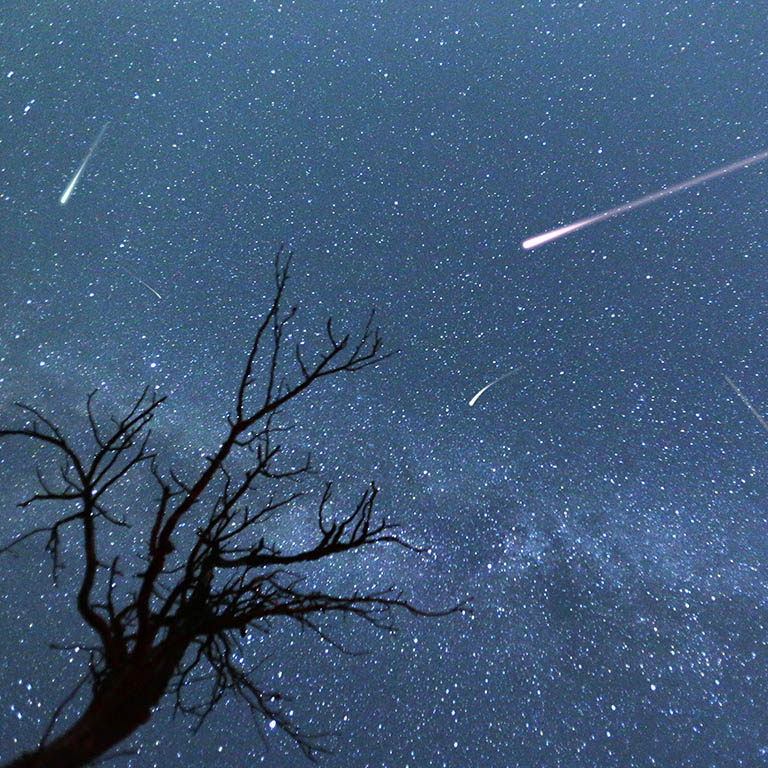BLOOMINGTON, Ind. -- The annual Perseid meteor shower is one of the most popular because it happens on warm summer nights, when gazing at the starry sky is always enjoyable. This year the Perseids will peak on the night of Aug. 12-13. Unfortunately the moon will be full just one day before that, so moonlight will strongly interfere with observing meteors. Even in a clear dark sky only the brightest meteors will be visible.
The Perseids will perform for most of August, though there will be fewer meteors to see the farther from the peak date you watch. If the peak is hidden by clouds, look for the bright streaks again as soon as the night sky is clear. To minimize the effect of local light pollution, try to avoid artificial lights.
Face east and look about halfway up the sky from the horizon. You won't need binoculars or a telescope, because the meteors move much too fast for those instruments. The Perseids produce more of the extremely bright meteors called fireballs than any other shower. The chances of seeing a fireball will be greatest near dawn.
The Perseids may appear anywhere in the sky, but they seem to originate from a point called the radiant in the constellation Perseus, which gives these "shooting stars" their name. The higher the radiant is above the northeastern horizon, the more meteors will be visible. Perseus is just north of the W-shaped constellation Cassiopeia in the Milky Way. Meteors near the radiant will have short trails because we see them nearly straight on, while those far from the radiant will look longer because they are seen from the side.
Most meteor showers happen when Earth crosses the orbit of a comet, and the Perseids come from Comet Swift-Tuttle. The meteors are caused by particles released from the comet's nucleus and left behind in space. As Earth plows through this stream of debris, ranging in size from sand grains to pebbles, each particle slams into our atmosphere at a speed of more than 30 miles per second and burns up almost instantly from friction with air molecules. The resulting heat momentarily creates a streak of glowing air that we see as a meteor. All of this happens about 60 miles above the ground, regardless of how close some meteors may appear.
Planets
Saturn will rise in the east soon after 9 p.m. local time on Aug. 1. It will be opposite the sun in our sky (at opposition) on Aug. 14, so it will be visible all night. The best time to view the planet will be when it is highest in the southern sky around 1 a.m., when it will be the brightest object in that part of the sky. This is the best time of year to view Saturn's rings, since the planet is closest to Earth at opposition. Titan, Saturn's largest moon, will be an easy target for small telescopes. Titan will be north of Saturn on Aug. 5 and 21, and south on Aug. 13 and 29.
Jupiter will rise during the hour before midnight on Aug. 1 and shortly before 9 p.m. by Aug. 31. The best views will be in the early morning hours when the planet will be high in the southern sky. It will be due south at 53 degrees altitude by 5 a.m. on Aug. 1 (an hour before sunrise) and by 3 a.m. on Aug. 31. Small telescopes will show dark equatorial belts, while larger scopes will show many spots including the Great Red Spot. The four Galilean moons orbit Jupiter every two to 16 days.
Mars and Uranus will rise together in the constellation Aries soon after midnight on Aug. 1. Mars will be easy to find, but Uranus will be much fainter, requiring binoculars to spot. Center Mars in binoculars and you'll find Uranus 1 degree north of the Red Planet. Mars will pass 6 degrees south of the Pleiades star cluster between Aug. 16 and 19, a pretty sight in binoculars. By Aug. 31 Mars will be 6 degrees northwest of similarly orange-red Aldebaran, the brightest star in the constellation Taurus. Mars will grow in apparent size during August. By the time it reaches opposition in December, Mars will be nearly double the size it is now.
Venus will be a brilliant "morning star" all month. On Aug. 1 it will rise in the constellation Gemini two hours before the sun. By Aug. 17 it will be 1 degree west of the Beehive star cluster. Look for the pair in binoculars about 4 degrees high an hour before sunrise.
Mercury will hug the western horizon all month, difficult to see in bright evening twilight.
Moon phases
The moon will be at first quarter on Aug. 5, full on Aug. 11, at last quarter on Aug. 19, and new on Aug. 27.
Author: Hal Kibbey Email: hkibbey [at] gmail.com


 The College of Arts
The College of Arts